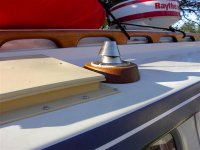Just thought of another issue, which the effect of condensation when the boat is unoccupied, either moored or on the trailer.
Condensation left alone in an empty boat can lead to mildew (mold/fungus) problems.
There are several ways to deal with this, again utilized alone or in combination:
The main solution is to provide for ventilation.
This can be done with either a solar/electric powered vent:
or a passive vent, operating with with the action of simple convection currents (moving of warm air) inside the boat during the daily heat cycle:

cowl vent, used more commonly on larger boats, and with dorade box underneath to eliminate rain water as well as spray underway.
********************
C-Dory roof top showing crank up vent on the left and heater exhaust vent (stainless steel) on right, Both provide ventilation at rest and when underway. The crank up vent has a screen across it to keep out bugs, and if only opened a little bit, provides quite a bit of ventilation but still keeps rain out.

There are additional ways to deal with condensation at rest.
Some folks use an 120-volt electric heater specifically designed to drive condensation up and out of the lower cabin area. Ventilation of the cabin by one of the methods above then removes it from the boat.
Link to description is
HERE. Many other types are available.
There are various configurations of these heaters, but the essential differences beween them and a home heater are that they are 1.) operating at a much lower temperature and electrical current draw, and that 2.) they are marine rated, which means they are designed to be sparkproof to insure against ignition of gasoline and other flamable vapors.
Additionaly, there are chemicals which are utilized to remove moisture from the air. These are desicated (dried out) crystals that are hydroscopic (attract and absorb moisture), but I can't see where they would absorb enough moisture to really get the job done in cold/humid climates.
********************
One other issue is moisture accumulating underneath the bedding in the V-berth where body moisture can accumulate in the bedding due to contact with the cold fiberglass panel underneath the sleeping area. The result is damp and cold bedding. Ick!
There are specific padding maetrials used tp combat this, and I'll let someone with experience with them describe them and their use. They usually come in flat stock and can be cut to fit the v-berth.
********************
That's all for now!
Joe. :teeth




